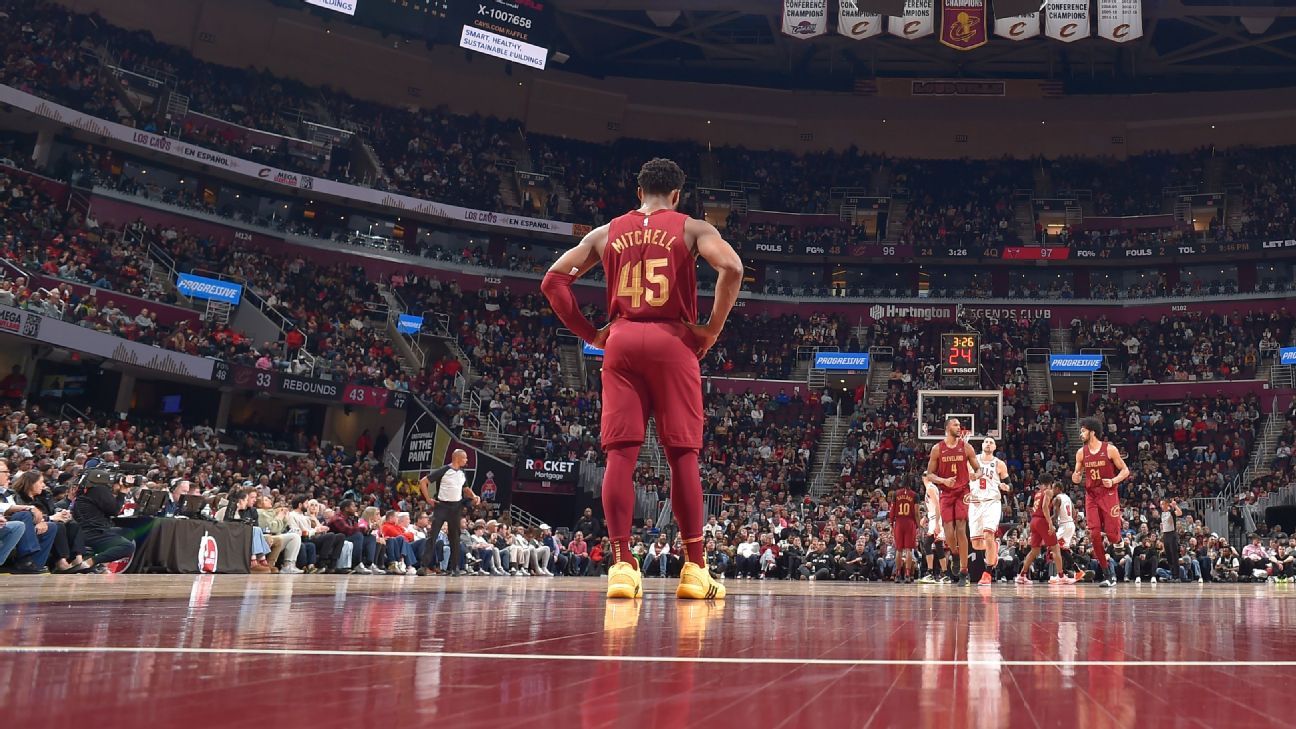Interesting article posted on ESPN. Since it’s behind a pay wall I’ve pasted the article for you:
After a quiet start to the NBA season, the Cleveland Cavaliers have surged toward the top of the Eastern Conference standings. But is this team actually a contender? Or is it all a mirage?

www.espn.com
TWO-AND-A-HALF months ago, the
Cleveland Cavaliers were teetering.
They had just lost their third straight game to fall to 13-12, falling to ninth place in the Eastern Conference, and just had All-Star guard
Darius Garland collide face-first with
Kristaps Porzingis' hip, leaving the floor general with a fractured jaw.
In the same news release in which the team announced Garland would miss four weeks, the Cavs also declared
Evan Mobley, who finished third in Defensive Player of the Year voting last season, would miss six to eight weeks to undergo arthroscopic surgery on his left knee.
The sky was falling in dreary Northeast Ohio.
Or so it seemed.
In their next game, against Atlanta, the shorthanded Cavs logged 41 points in the first quarter -- the most J.B. Bickerstaff's team had scored in a period all season -- en route to a eight-point win over the Hawks.
They've barely lost since.
The Cavaliers, with an NBA-best 23-5 mark from Dec. 15 to the All-Star Game, have scaled
seven spots over the past 2½ months to sit in second place in the Eastern Conference heading into the weekend.
All of which raises two fundamental questions -- both of which could shift the balance of power in the East.
How? And, perhaps more important, is it real?
BEING DOWN A star ball handler in today's
offense-heavy NBA can derail a team's entire scoring attack. Yet the Cavs did more than merely avoid pitfalls. Instead, they created all sorts of tricks and traps to confound their opponents.
Donovan Mitchell, predictably, handled the ball far more while Garland was out. But rather than carry more of the team's scoring burden on his shoulders, Mitchell made use of the added defensive attention by spraying the ball around when defenses collapsed onto him.
Consider: Mitchell passed out of his drives to the basket almost 39% of the time during the 1½ months that Garland missed, up from the 33% pass rate he had before Garland's absence. The result: Mitchell, who averaged 4.5 assists with Cleveland last season, averaged nearly eight dimes with Garland out of the lineup.
Max Strus, the free agent newcomer from Miami, has also worked passing wonders, already having logged far more assists this season (227) than he did in 80 games during the 2022-23 campaign (171), which served as his previous career high.
Without their usual backcourt, the Cavs moved the ball at a better clip, too, going from 277.8 passes per game before Garland's injury -- a rate that ranked 18th in the league at the time -- to a league-high 312.2 with Garland out. The Cavs' assist percentage also jumped from 60.2% (20th) before Garland's injury to 66.5% (eighth) in the time he missed. Taken together, Cleveland's offense jumped from 25th in the league in efficiency at the time of Garland's injury to sixth during the 19 games he sat out.
The shift didn't come about by happenstance. This was a concerted effort to beat teams with the pass. Bickerstaff saw an opportunity, with the non-shooting Mobley out, to spread opponents out even more. Rather than allow teams to load up on Mitchell during his isolation looks, more passing would force defenses to chase, giving players more looks from 3.
"That's what you have to do when you're down your more talented players," Bickerstaff told reporters after a blowout win in January over Washington. "We're trying to jack as many 3s as we possibly can." (Days later, Cleveland took a franchise-record 57 triples in a win over Chicago.)
The Cavaliers accomplished the mission. Aside from giving center
Jarrett Allenmore space to operate -- in Mobley's absence, he logged a franchise-record 16 straight double-doubles from late December to the end of January -- Cleveland has become a far bigger threat from outside. The Cavs ranked 26th in 3-pointers and 21st in 3-point tries prior to the Mobley injury, but ranked fourth in makes and third in tries while the big man was rehabbing.
The shift in shot profile was on full display during the comeback victory against Dallas on Tuesday. With Cleveland down 10 with just under four minutes remaining, Strus hit triples on four-straight possessions to bring the Cavaliers within one point.
Mitchell then hit a pair of 3s, setting up one of the most dramatic moments of the NBA season. After the Mavs scored what looked to be a game-winning layup with 2.6 seconds left, Strus took an inbound and launched a 59-foot, buzzer-beating heave that scorched the net to steal the Cavaliers a victory and send the Rocket Mortgage FieldHouse into a tizzy.
BUT ARE THEY for real? As in, an actual threat?
No team in the NBA had a cushier schedule than the Cavs over those last 20 games before the break, which included three against the lowly Wizards, two against the Spurs, two against the Nets, two against the Bulls, and ones versus the Grizzlies and Pistons.
But what about the victory over the red-hot Clippers in January, or the multiple wins against the Bucks? Even if Cleveland's slate was soft, they outperformed expectations; especially while down two key starters for much of that time. (Based on each matchup's pregame expectations, and taking into account injuries, the Cavs were anticipated to finish 14-6 during that 20-game slate, according to data from ESPN Analytics.)
If questions remain about their legitimacy, consider this: The Cavs' 18-2 run heading into All-Star Weekend is the second hottest 20-game run in history into the break. The only team to do better was the 1964-65 Celtics (19-1), who went on to win the NBA title that season.
You simply can't win at such a level for a quarter of the NBA season and fake it.
But the team knows skeptics remain.
"I think it's just based off of last year's playoff performance. It's a product of our team as well. We're not getting that recognition, that love, because of how we finished last season," Mitchell told reporters, referring to their first-round dismissal at the hands of the
New York Knicks. "Ultimately, you're as good as your last playoffs."
Still, there is precedent to monitor regarding the rapid ascent. It was only two years ago that the Celtics, under then-first-year coach Ime Udoka, had a similar run in the East, starting slowly before racing from the back of the pack to land the conference's No. 1 seed with an NBA-best 26-6 run from New Year's Eve to the end of the season. (Boston had an average slate -- the 14th-easiest schedule -- during that span.) That team reached the NBA Finals.
Can Cleveland maintain enough of its principles -- the increased passing and the open looks from deep those passes create -- from December and January against better competition now that Garland and Mobley are back?
Bickerstaff has now seen that other lineups can work. The Mitchell, Strus, Allen,
Isaac Okoro and
Dean Wade group has outscored opponents by 28.7 points per 100 possessions -- the NBA's second-most efficient five-man lineup among those that have logged 150 minutes since Jan. 3.
If they do regress, it won't be because of their defense, which remains elite, ranking among the NBA's best in rim protection, limiting clubs in transition and baiting teams into -- then absolutely stifling -- repeated one-on-one attempts. As such, Cleveland is 11-0 when holding opponents under 100 points.
The real thing to watch, though, after a quick first-round exit in which they were absolutely dominated on the glass by the Knicks last postseason, is how the Cavaliers rebound the basketball.
After a slow start, Cleveland has seen marked improvement on the glass. The club was poor at corralling misses prior to Mobley leaving the lineup in early December, ranking 22nd in the league in rebound percentage and 20th in defensive rebound percentage -- subpar metrics that were almost identical to where the Cavaliers ranked last season. In the seven weeks without Mobley, though, Allen and the team improved considerably, grabbing 52.7% of available rebounds and 74.1% of available defensive boards; numbers that ranked third- and second-best in the NBA, respectively, during that span.
Is that improvement enough to quiet the doubts that still exist about the team after last year's playoff flameout? Perhaps not. (It's only fair to mention here that Cleveland got absolutely manhandled on the boards, 74-39, in its Thursday double-overtime loss to the Bulls this past week, reinforcing those questions about toughness.) The unexpected hot streak heading into the All-Star break -- even without two of its stars -- might not have been enough, either.
But in an Eastern Conference where essentially every team aside from Boston has shown some sort of blemish lately, the Cavs have made enough tweaks and shown enough improvement from their top-end talent to be taken seriously as a contender -- even without a playoff series victory on this group's mantel.

